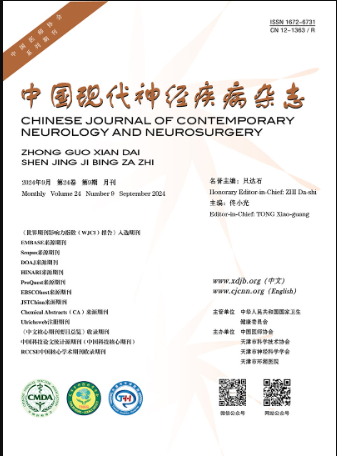Thrombectomy with Solitaire stent for treating acute middle cerebral artery occlusion
Q4 Medicine
引用次数: 0
Abstract
Objective To assess the efficacy and safety of thrombectomy with Solitaire stent for treatment of acute middle cerebral artery occlusion (MCAO), and to identify the predictive factors for clinical outcome. Methods A total of 25 patients with acute middle cerebral artery (MCA)-M1 segment occlusion were treated by thrombectomy with Solitaire stent. Time from onset to femoral artery puncture, time from femoral artery puncture to recanalization, times of thrombectomy, thrombolytic therapy or not, balloon dilatation and/or stent implantation, intraarterial thrombolysis or not, tirofiban treatment after therapy or not were recorded. Vascular recanalization immediately after procedure was evaluated by Thrombolysis in Cerebral Infarction (TICI). National Institutes of Health Stroke Scale (NIHSS) was used to evaluate neurological function of patients 24 h after operation, and the clinical outcomes were assessed by modified Rankin Scale (mRS) at 90 d after treatment. The occurrence rate of symptomatic intracranial hemorrhage within 24 h after operation and mortality within 90 d after treatment were recorded. Results Median time from onset to femoral artery puncture was 5.00 (4.00, 6.30) h; median time from femoral artery puncture to recanalization was 2.00 (2.00, 2.50) h; times of thrombectomy was 2 (2, 2); 7 patients (28%) received intravenous thrombolysis before thrombectomy; 6 patients (24%) underwent balloon dilatation only; 3 patients (12%) underwent stent implantation only; 4 patients (16%) underwent balloon dilatation and stent implantation; 4 patients (16%) received intraarterial thrombolysis after thrombectomy; 11 (44%) received tirofiban therapy after operation. There were 20 patients (80% ) of recanalization with TICI 2b-3 grade. The NIHSS score at 24 h after operation was significantly decreased than before procedure [8 (4, 12) score vs. 14 (11, 17) score; Z = -3.532, P = 0.000]. Symptomatic intracranial hemorrhage occurred in 3 patients (12%). At 90 d after treatment, 15 patients (60%) had favorable prognosis (mRS ≤ 2 score). Two patients (8%) died. Univariate and multivariate forward Logistic regression analysis showed the TICI 2b-3 grade was independent factor for favorable prognosis ( OR = 0.316, 95% CI: 0.102-0.982; P = 0.046). Conclusions Thrombectomy with Solitaire stent is safe and effective for treating acute MCAO. With the increase of TICI grade, the prognosis is better. DOI: 10.3969/j.issn.1672-6731.2017.11.004Solitaire支架血栓切除术治疗急性大脑中动脉闭塞
目的评价Solitaire支架取栓治疗急性大脑中动脉闭塞(MCAO)的疗效和安全性,并探讨其临床预后的预测因素。方法对25例急性大脑中动脉(MCA)-M1段闭塞患者行支架取栓术。记录从发病至股动脉穿刺时间、股动脉穿刺至再通时间、取栓次数、是否溶栓、球囊扩张及/或支架置入术、是否动脉溶栓、治疗后是否使用替罗非班。手术后立即血管再通通过脑梗死溶栓(TICI)进行评估。术后24 h采用美国国立卫生研究院卒中量表(NIHSS)评估患者神经功能,治疗后90 d采用改良Rankin量表(mRS)评估临床疗效。记录术后24 h内症状性颅内出血发生率及治疗后90 d内病死率。结果从发病到穿刺股动脉的中位时间为5.00 (4.00,6.30)h;从股动脉穿刺到再通的中位时间为2.00 (2.00,2.50)h;取栓次数为2次(2,2);取栓前静脉溶栓7例(28%);6例(24%)仅行球囊扩张术;仅行支架植入术3例(12%);行球囊扩张及支架置入术4例(16%);取栓后行动脉溶栓4例(16%);11例(44%)术后接受替罗非班治疗。有20例患者(80%)再通,TICI为2b-3级。术后24 h NIHSS评分明显低于术前[8(4,12)分比14(11,17)分;Z = -3.532, p = 0.000]。出现症状性颅内出血3例(12%)。治疗后90 d, 15例(60%)患者预后良好(mRS≤2分)。2例(8%)死亡。单因素和多因素正向Logistic回归分析显示,TICI 2b-3分级是预后良好的独立因素(OR = 0.316, 95% CI: 0.102 ~ 0.982;P = 0.046)。结论支架取栓是治疗急性MCAO安全有效的方法。随着TICI分级的增加,预后较好。DOI: 10.3969 / j.issn.1672-6731.2017.11.004
本文章由计算机程序翻译,如有差异,请以英文原文为准。
求助全文
约1分钟内获得全文
求助全文

 求助内容:
求助内容: 应助结果提醒方式:
应助结果提醒方式:


